The Tamil Nadu floods have once again brought life to a standstill in many parts of the state, with Chennai and surrounding areas bearing the brunt of the recent heavy rainfall. Triggered by a depression in the Bay of Bengal, the downpour has caused severe waterlogging, disrupted transport services, and forced thousands of residents to take refuge in relief centers. As the rains persist, authorities are racing to manage the crisis with a coordinated response across the state.
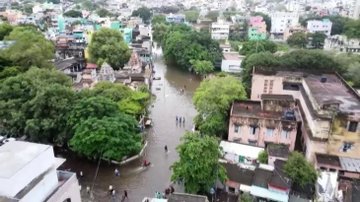
Unrelenting Rains Cause Flooding Across Tamil Nadu
The depression over the west-central Bay of Bengal moved inland on the night of October 16, causing widespread heavy rain in Tamil Nadu, particularly in Chennai and neighboring districts like Kancheepuram, Tiruvallur, and Chengalpattu. The Indian Meteorological Department (IMD) issued a red alert for these areas, predicting even more rainfall in the coming days.
While several parts of Chennai saw some respite from waterlogging by October 17, low-lying areas such as Pallikaranai and Ambedkar Nagar remained submerged in knee-deep water. The continuous rainfall has made it difficult for the water to recede, further worsening the situation in these flood-prone areas.
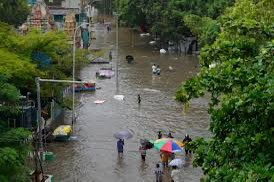
Impact on Daily Life
Chennai, a city home to over 11 million people, has been particularly hard hit. Roads in many parts of the city have turned into rivers, disrupting both public and private transportation. Several bus services have been canceled, and autorickshaws have disappeared from the streets due to safety concerns. The Southern Railway had to cancel key express trains, including the Chennai-Mysuru Kaveri Express, due to waterlogged tracks, while some domestic flights were delayed or canceled.
In addition to transportation woes, businesses have taken a hit, and many offices have been forced to switch to remote work. Schools, colleges, and government offices in Chennai and nearby districts remain closed as the government extends holidays in the face of the ongoing crisis. The shutdown aims to minimize travel and prevent accidents as the state braces for more heavy rain.
Relief Efforts and Government Response
In a quick response to the Tamil Nadu floods, the state government has opened over 5,000 relief centers across the state, providing food, shelter, and medical aid to people displaced by the flooding. In Chennai, Amma canteens are offering free meals to those affected by the heavy rains.
The Greater Chennai Corporation (GCC) has deployed thousands of workers along with equipment such as pumps and tractors in flood-prone areas like Velachery, Pallikaranai, and T Nagar. Special teams from the National Disaster Response Force (NDRF) and State Disaster Response Force (SDRF) have been stationed across the coastal districts to manage the emergency. Boats have been mobilized for rescue operations, and relief materials, including food and clean drinking water, have been distributed in hard-hit areas.
Tamil Nadu Chief Minister MK Stalin and Deputy Chief Minister Udhayanidhi Stalin have been actively overseeing the relief operations. Udhayanidhi visited several flood-affected areas and inspected the Integrated Command and Control Centre, ensuring a coordinated response between various agencies to tackle the waterlogging issues. The government has also set up helplines and is providing regular updates to residents.

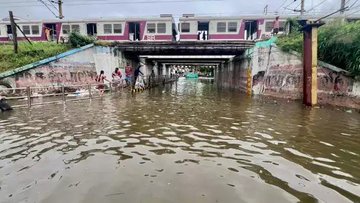
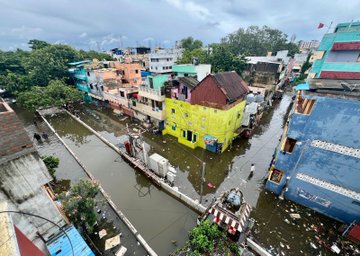
Power Disruptions and Infrastructure Damage
While electricity supply has remained stable in most areas, certain flood-prone localities have experienced power cuts as a safety precaution. The Tamil Nadu Generation and Distribution Company (Tangedco) has assigned nodal officers to oversee immediate relief measures related to electricity distribution in each zone of the Greater Chennai Corporation. These officers are responsible for fixing technical faults, replacing damaged electric poles, and cutting off power supply in waterlogged areas to avoid electrical accidents.
Moreover, the ongoing metro rail work in Chennai has exacerbated the problem in several areas. In regions like Mylapore, stormwater drains (SWD) have been damaged, leading to increased flooding. This has prompted demands for better coordination between the Chennai Metro Rail Limited (CMRL) and city authorities to prevent such issues in the future.
Challenges in Flood Mitigation Efforts
One of the major issues in flood management has been the incomplete and delayed stormwater drain projects across Chennai. Despite the Greater Chennai Corporation’s claims that 92% of SWD work was completed by November 2023, several key areas like Thiruvottiyur, Ambattur, and Sholinganallur are still awaiting the completion of essential infrastructure.
In areas where stormwater drains have been constructed, residents fear that overflowing canals and rivers may still cause flooding. For example, the Kodungaiyur canal in north Chennai frequently overflows during heavy rains, flooding nearby residential areas. Similar concerns have been raised in Tondiarpet, where canals like the Buckingham Canal pose a significant flood risk.
In addition to incomplete SWD projects, the capacity of Chennai’s water channels, rivers, and canals remains insufficient to handle the massive inflow of rainwater. The state’s failure to clear encroachments and restore water bodies to their original capacities has contributed to the severity of the floods.
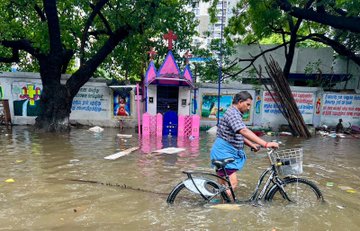
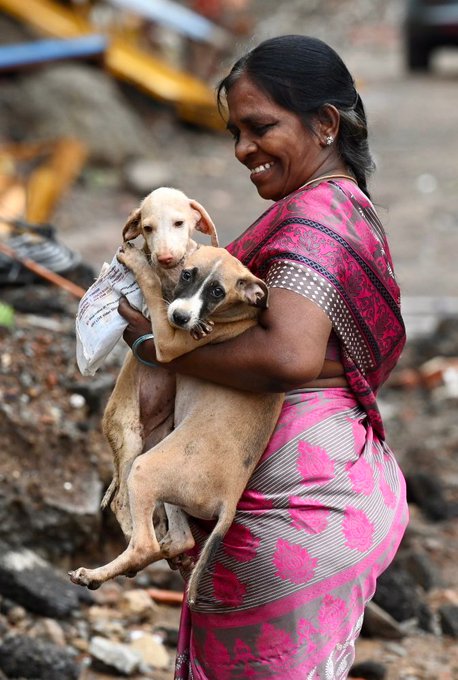
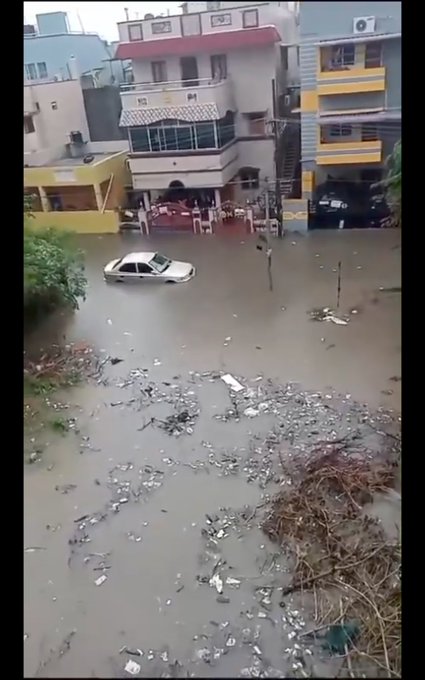
Power Consumption and Agricultural Relief
The heavy rains have also led to a reduction in electricity consumption across Tamil Nadu. As temperatures have dropped, the need for air conditioners and other cooling devices has diminished, leading to a sharp fall in power demand. According to Tangedco, the state’s power consumption has dropped from 380 million units per day to 302 million units per day since the rains began.
Farmers in the state have welcomed the downpour, as it has filled up farmlands and reduced their reliance on motor pumps to draw water from borewells. This natural irrigation has provided much-needed relief to agricultural communities that were facing water shortages.
Future Outlook and Preparations
The IMD has forecast that heavy rains will continue in Tamil Nadu and parts of Karnataka until October 19, after which the intensity is expected to decrease. Although the rains are likely to taper off, the state government remains vigilant, with relief teams on standby and flood control measures in place.
Moving forward, experts and activists have called for more comprehensive flood mitigation strategies in Tamil Nadu. This includes restoring the capacity of water bodies, improving the efficiency of stormwater drain networks, and ensuring better coordination between various government agencies, including the CMRL, to minimize the impact of future monsoons.
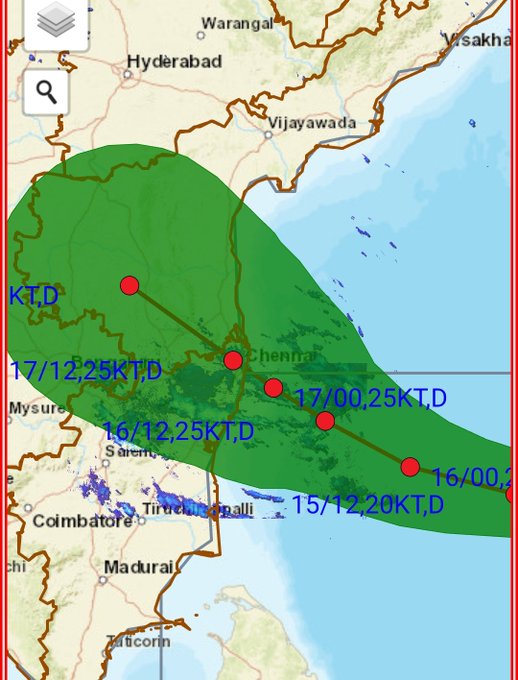
Conclusion
The Tamil Nadu floods have once again highlighted the city’s vulnerability to heavy rainfall and the ongoing challenges in flood management. Despite the swift response from the government and relief agencies, long-term solutions such as improving water infrastructure, restoring natural water bodies, and removing encroachments remain essential to prevent future disasters. As the rains subside, Chennai and other affected areas will need to focus on recovery and strengthening their defenses against the next monsoon.
Specifications Overview (Box Table)
| Feature | Details |
|---|---|
| Location | Tamil Nadu, Chennai |
| Weather Event | Depression over the Bay of Bengal |
| Rainfall (Oct 16) | 125mm (Chennai) |
| Affected Areas | Chennai, Kancheepuram, Tiruvallur, Chengalpattu |
| Relief Centers Opened | 5,141 across Tamil Nadu |
| Power Consumption Drop | 302 million units/day (from 380 million) |
| Emergency Teams | NDRF, SDRF, Tangedco |
| Metro Work Impact | Stormwater drain damage |
| Anticipated Rainfall | Until October 19 |
This table summarizes the essential details of the Tamil Nadu flood situation, providing a quick overview of the key factors involved in the ongoing crisis.


